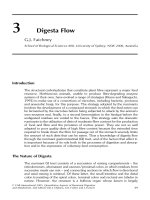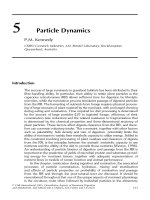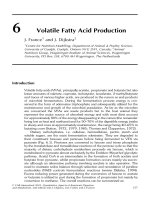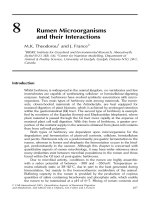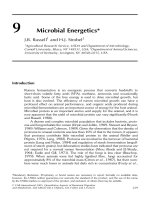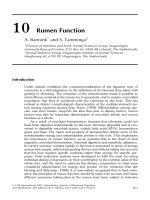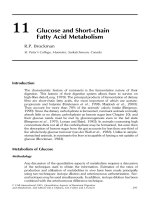Quantitative aspects of ruminant digestion and metabolism - Phần 1
Bạn đang xem bản rút gọn của tài liệu. Xem và tải ngay bản đầy đủ của tài liệu tại đây (483.88 KB, 60 trang )
Q
UANTITATIVE
A
SPECTS OF
R
UMINANT
D
IGESTION AND
M
ETABOLISM
Second Edition
This page intentionally left blank
Q
UANTITATIVE
A
SPECTS
OF
R
UMINANT
D
IGESTION
AND
M
ETABOLISM
Second Edition
Edited by
J. Dijkstra
Animal Nutrition Group
Wageningen University
The Netherlands
J.M. Forbes
Centre for Animal Sciences
University of Leeds
UK
and
J. France
Centre for Nutrition Modelling
University of Guelph
Canada
CABI Publishing
CABI Publishing is a division of CAB International
CABI Publishing CABI Publishing
CAB International 875 Massachusetts Avenue
Wallingford 7th Floor
Oxfordshire OX10 8DE Cambridge, MA 02139
UK USA
Tel: þ44 (0)1491 832111 Tel: þ1 617 395 4056
Fax: þ44 (0)1491 833508 Fax: þ1 617 354 6875
E-mail: E-mail:
Web site: www.cabi-publishing.org
ßCAB International 2005. All rights reserved. No part of this publication
may be reproduced in any form or by any means, electronically,
mechanically, by photocopying, recording or otherwise, without the
prior permission of the copyright owners.
A catalogue record for this book is available from the British Library, London, UK.
A catalogue record for this book is available from the Library of Congress, Washington, DC,
USA.
Library of Congress Cataloging-in-Publication Data
Quantitative aspects of ruminant digestion and metabolism / edited by J. Dijkstra, J. M. Forbes,
and J. France.- -2nd ed.
p. cm.
Includes index.
ISBN 0–85199–814–3 (alk. paper)
1. Rumination. 2. Digestion. 3. Metabolism. 4. Ruminants. I. Dijkstra, J. (Jan), 1964– II.
Forbes, J. M. (John Michael), 1940–III. France, J. IV. Title.
QP151.Q78 2005
573.3’1963- -dc22
2004029078
ISBN 0 85199 8143
Typeset by SPI Publishing Services, Pondicherry, India
Printed and bound in the UK by Biddles Ltd, King’s Lynn
Contents
Contributors ix
1. Introduction 1
J. Dijkstra, J.M. Forbes and J. France
DIGESTION
2. Rate and Extent of Digestion 13
D.R. Mertens
3. Digesta Flow 49
G.J. Faichney
4. In Vitro and In Situ Techniques for Estimating Digestibility 87
S. Lo
´
pez
5. Particle Dynamics 123
P.M. Kennedy
6. Volatile Fatty Acid Production 157
J. France and J. Dijkstra
7. Nitrogen Transactions in Ruminants 177
J.V. Nolan and R.C. Dobos
8. Rumen Microorganisms and their Interactions 207
M.K. Theodorou and J. France
v
9. Microbial Energetics 229
J.B. Russell and H.J. Strobel
10. Rumen Function 263
A. Bannink and S. Tamminga
METABOLISM
11. Glucose and Short-chain Fatty Acid Metabolism 291
R.P. Brockman
12. Metabolism of the Portal-drained Viscera and Liver 311
D.B. Lindsay and C.K. Reynolds
13. Fat Metabolism and Turnover 345
D.W. Pethick, G.S. Harper and F.R. Dunshea
14. Protein Metabolism and Turnover 373
D. Attaix, D. Re
´
mond and I.C. Savary-Auzeloux
15. Interactions between Protein and Energy Metabolism 399
T.C. Wright, J.A. Maas and L.P. Milligan
16. Calorimetry 421
R.E. Agnew and T. Yan
17. Metabolic Regulation 443
R.G. Vernon
18. Mineral Metabolism 469
E. Kebreab and D.M.S.S. Vitti
THE WHOLE ANIMAL
19. Growth 489
G.K. Murdoch, E.K. Okine, W.T. Dixon, J.D. Nkrumah,
J.A. Basarab and R.J. Christopherson
20. Pregnancy and Fetal Metabolism 523
A.W. Bell, C.L. Ferrell and H.C. Freetly
21. Lactation: Statistical and Genetic Aspects of Simulating
Lactation Data from Individual Cows using a Dynamic,
Mechanistic Model of Dairy Cow Metabolism 551
H.A. Johnson, T.R. Famula and R.L. Baldwin
vi Contents
22. Mathematical Modelling of Wool Growth at the Cellular
and Whole Animal Level 583
B.N. Nagorcka and M. Freer
23. Voluntary Feed Intake and Diet Selection 607
J.M. Forbes
24. Feed Processing: Effects on Nutrient Degradation
and Digestibility 627
A.F.B. Van der Poel, E. Prestløkken and J.O. Goelema
25. Animal Interactions with their Environment:
Dairy Cows in Intensive Systems 663
T. Mottram and N. Prescott
26. Pasture Characteristics and Animal Performance 681
P. Chilibroste, M. Gibb and S. Tamminga
27. Integration of Data in Feed Evaluation Systems 707
J.P. Cant
Index 727
Contents vii
This page intentionally left blank
Contributors
R.E. Agnew, Agricultural Research Institute of Northern Ireland, Large
Park, Hillsborough BT26 6DR, UK.
D. Attaix, Institut National de la Recherche Agronomique, Unite
´
de Nutri-
tion et Me
´
tabolisme Prote
´
ique, Theix, 63122 Ceyrat, France.
R.L. Baldwin, Department of Animal Science, University of California,
Davis, CA 95616-8521, USA.
A. Bannink, Division of Nutrition and Food, Animal Sciences Group,
Wageningen University Research Centre, PO Box 65, 8200 AB Lelys-
tad, The Netherlands.
J.A. Basarab, Western Forage/Beef Group, Lacombe Research Centre,
6000 CandE Trail, Lacombe, Alberta T4L 1W1, Canada .
A.W. Bell, Department of Animal Science, Cornell University, Ithaca, NY
14853, USA.
R.P. Brockman, St. Peter’s College, Muenster, Saskatchewan S0K 2Y0,
Canada.
J.P. Cant, Department of Animal and Poultry Science, University of
Guelph, Guelph, Ontario N1G 2W1, Canada.
P. Chilibroste, Facultad de Agronomı
´
a, Estacio
´
n Experimental M. A. Cassi-
noni, Ruta 3 km 363, CP 60000, Paysandu
´
, Uruguay.
R.J. Christopherson, Department of Agricultural, Food and Nutritional
Science, University of Alberta, Edmonton, Alberta T6G 2P5, Canada.
J. Dijkstra, Animal Nutrition Group, Wageningen Institute of Animal Sci-
ences, Wageningen University, PO Box 338, 6700 AH Wageningen,
The Netherlands.
W.T. Dixon, Department of Agricultural, Food and Nutritional Science,
University of Alberta, Edmonton, Alberta T6G 2P5, Canada.
R.C. Dobos, Beef Industry Centre of Excellence, NSW Department of
Primary Industries, Armidale, 2351 Australia.
ix
F.R. Dunshea, School of Veterinary and Biomedical Sciences, Murdoch
University, Murdoch, WA 6150, Australia; and Department of Pri-
mary Industries, Werribee, VIC 3030, Australia.
G.J. Faichney, School of Biological Sciences A08, University of Sydney,
NSW 2006, Australia.
T.R. Famula, Department of Animal Science, University of California,
Davis, CA 95616-8521, USA.
C.L. Ferrell, USDA ARS, Meat Animal Research Center, Clay Center, NE
68933, USA.
J.M. Forbes, Centre for Animal Sciences, School of Biology, University of
Leeds, Leeds LS2 9JT, UK.
J. France, Centre for Nutrition Modelling, Department of Animal and
Poultry Science, University of Guelph, Guelph, Ontario N1G 2W1,
Canada.
M. Freer, CSIRO Plant Industry, GPO Box 1600, Canberra, ACT 2601,
Australia.
H.C. Freetly, USDA ARS, Meat Animal Research Center, Clay Center, NE
68933, USA.
M. Gibb, Institute of Grassland and Environmental Research, North Wyke
Research Station, Okehampton, Devon EX20 2SB, UK.
J.O. Goelema, Pre-Mervo, PO Box 40248, 3504 AA Utrecht, The Nether-
lands.
G.S. Harper, CSIRO, Division of Livestock Industries, St. Lucia, QLD
4067, Australia.
H.A. Johnson, Department of Animal Science, University of California,
Davis, CA 95616-8521, USA.
E. Kebreab, Centre for Nutrition Modelling, Department of Animal and
Poultry Science, University of Guelph, Guelph, Ontario N1G 2W1,
Canada.
P.M. Kennedy, CSIRO Livestock Industries, J.M. Rendel Laboratory, Rock-
hampton, QLD 4701, Australia.
D.B. Lindsay, Division of Nutritional Sciences, School of Biosciences, Uni-
versity of Nottingham, Sutton Bonington Campus, Loughborough,
Leicestershire LE12 5RD, UK.
S. Lo
´
pez, Department of Animal Production, University of Leon, 24071
Leon, Spain.
J.A. Maas, Centre for Integrative Biology, University of Nottingham, Sut-
ton Bonnington, Leicestershire LE12 5RD, UK.
D.R. Mertens, USDA – Agricultural Research Service, US Dairy Forage
Research Center, Madison, WI 53706, USA.
L.P. Milligan, Department of Animal and Poultry Science, University of
Guelph, Guelph, Ontario N1G 2W1, Canada.
T. Mottram, Silsoe Research Institute, Wrest Park, Silsoe, Bedford MK45
4HS, UK.
G.K. Murdoch, Department of Agricultural, Food and Nutritional Science,
University of Alberta, Edmonton, Alberta T6G 2P5, Canada.
x Contributors
B.N. Nagorcka, CSIRO Livestock Industries, GPO Box 1600, Canberra,
ACT 2601, Australia.
J.D. Nkrumah, Department of Agricultural, Food and Nutritional Science,
University of Alberta, Edmonton, Alberta T6G 2P5, Canada.
J.V. Nolan, School of Rural Science and Agriculture, University of New
England, Armidale, 2351 Australia.
E.K. Okine, Department of Agricultural, Food and Nutritional Science,
University of Alberta, Edmonton, Alberta T6G 2P5, Canada.
D.W. Pethick, School of Veterinary and Biomedical Sciences, Murdoch
University, Murdoch, WA 6150, Australia.
N. Prescott, Silsoe Research Institute, Wrest Park, Silsoe, Bedford MK45
4HS, UK.
E. Prestløkken, Felleskjøpet Fo
ˆ
rutvikling, Department of Animal and Aqua-
cultural Sciences, Agricultural University of Norway, PO Box 5003,
N-1432 A
˚
s, Norway.
D. Re
´
mond, Institut National de la Recherche Agronomique, Unite
´
de
Nutrition et Me
´
tabolisme Prote
´
ique, Theix, 63122 Ceyrat, France.
C.K. Reynolds, Department of Animal Sciences, The Ohio State University,
OARDC, 1680 Madison Avenue, Wooster, OH 44691-4096 USA.
J.B. Russell, Agricultural Research Service, USDA and Department of
Microbiology, Cornell University, Ithaca, NY 148531, USA.
I.C. Savary-Auzeloux, Institut National de la Recherche Agronomique,
Unite
´
de Recherches sur les Herbivores, Theix, 63122 Ceyrat, France.
H.J. Strobel, Department of Animal Sciences, University of Kentucky,
Lexington, KY 40546-0215, USA.
S. Tamminga, Animal Nutrition Group, Wageningen Institute of Animal
Sciences, Marijkeweg 40, 6709 PG Wageningen, The Netherlands.
M.K. Theodorou, BBSRC Institute for Grassland and Environmental Re-
search, Aberystwyth, Dyfed SY23 3EB, UK.
A.F.B. Van der Poel, Wageningen University, Animal Nutrition Group,
Marijkeweg 40, 6709 PG Wageningen, The Netherlands.
R.G. Vernon, Hannah Research Institute, Ayr KA6 5HL, UK.
D.M.S.S. Vitti, Animal Nutrition Laboratory, Centro de Energia Nuclear na
Agricultura, Caixa Postal 96, CEP 13400-970, Piracicaba, SP, Brazil.
T.C. Wright, Department of Animal and Poultry Science, University of
Guelph, Guelph, Ontario N1G 2W1, Canada.
T. Yan, Agricultural Research Institute of Northern Ireland, Large Park,
Hillsborough BT26 6DR, UK.
Contributors xi
This page intentionally left blank
1
Introduction
J. D
IJKSTRA
,
1
J.M. F
ORBES
2
and J. F
RANCE
3
1
Animal Nutrition Group, Wageningen Institute of Animal Sciences,
Wageningen University, P.O. Box 338, 6700 AH Wageningen,
The Netherlands;
2
Centre for Animal Sciences, School of Biology,
University of Leeds, Leeds LS2 9JT, UK;
3
Centre for Nutrition Modelling,
Department of Animal & Poultry Science, University of Guelph, Guelph,
Ontario N1G 2W1, Canada
Preamble
Ruminant animals have evolved a capacious set of stomachs that harbour
microorganisms capable of digesting fibrous materials, such as cellulose. This
allows ruminants to eat and partly digest plants, such as grass, which have a
high fibre content and low nutritional value for simple-stomached animals.
Thus, animals of the suborder Ruminantia, being plentiful and relatively easy
to trap, became prime targets of hunters and, eventually, were domesticated
and farmed. Today, ruminants account for almost all of the milk and approxi-
mately one-third of the meat production worldwide (Food and Agriculture
Organization, 2004) (Fig. 1.1). It is not surprising, then, that a great deal of
research has been carried out on the digestive system of ruminants, leading to
studies on the peculiarities of metabolism that cope with the unusual products
of microbial digestion. The reading list at the end of this chapter gives some of
the books in which the biology of ruminants is reviewed.
As qualitative knowledge increased, so it became possible to develop
quantitative approaches to increase understanding further and to integrate
various aspects. Initially this was achieved by more complex statistical analysis,
but in recent years this has been supplemented by dynamic mathematical
models that not only summarize existing data but also show where gaps in
knowledge exist and where further research should be done. The purpose of
this book is to bring together the quantitative approaches, concerned with
elucidating mechanisms, used in the study of ruminant digestion, metabolism
and related areas. In this introductory chapter, we describe briefly the special
features of the ruminant and the potential for quantitative description of
ruminant physiology to contribute to our understanding. We also indicate the
chapters in which detailed consideration is given to each topic. This chapter is
based firmly on Chapter 1 of the previous edition of this book (Forbes and
France, 1993). However, all the subsequent chapters in this second edition are
ß CAB International 2005. Quantitative Aspects of Ruminant Digestion
and Metabolism, 2nd edition (eds J. Dijkstra, J.M. Forbes and J. France)
1
either major revisions of the old chapters or, in the majority of cases, com-
pletely new chapters written either by old or new authors.
Special Features of the Ruminant
The gastrointestinal tract
Reticulorumen
As there is no sphincter between the rumen and the reticulum and they
function to a large extent as a single organ, they are usually considered
together. Feed, after being chewed during eating, enters the reticulorumen
where it is subjected to microbial attack and to the mixing and propulsive forces
generated by coordinated contractions of the reticulorumen musculature. This
muscular activity results in the pattern of movement of digesta that is shown
diagrammatically in Fig. 1.2. It is coordinated not only to mix the digesta but
also to allow the removal of fermentation gases by eructation, the regurgitation
of digesta for rumination, which is largely responsible for the physical break-
down of digesta particles (see Chapter 5), and the passage of digesta out of the
reticulorumen through the reticulo-omasal orifice (see Chapter 3). The rate and
extent of degradation in the reticulorumen and developments in techniques to
estimate the rate and extent are described in Chapters 2 and 4, respectively.
The microbial activity in the reticulorumen gives the host the ability to eat
and utilize forages. Chapters 8 and 9 review the dynamics and energetics of this
microbial population. Most of the material digested in the rumen yields short-
chain fatty acids, known as volatile fatty acids (VFA), which are absorbed
through the rumen wall. Acetic acid is produced in the greatest quantities,
around 20–50 moles per day in dairy cows, while propionic acid is usually
produced at about one-third of the rate of acetic acid. Butyric acid accounts for
around 10% of the total acid production, while valeric and isovaleric acids each
Beef and veal
Buffalo
Goat
Mutton and lamb
Other ruminants
Non-ruminants
Non-ruminants
Buffalo
Sheep
Goat
Cow
Fig. 1.1. Relative contribution of various groups of ruminants and non-ruminants to the
production of meat (left graph) and milk (right graph) worldwide in 2003 (Food and Agriculture
Organization, 2004).
2 J. Dijkstra et al.
form about 1% to 2%. The ratio of acetic:propionic acids is higher for forage
diets than for concentrate diets (see Chapters 6 and 10).
Much of the dietary protein, as well as the urea that is recycled via the
saliva, is metabolized to ammonia. Both ammonia and amino acids or small
peptides are available for microbial protein synthesis (see Chapters 7 and 10).
Omasum
Digesta pass from the reticulum to the omasum via a sphincter, the reticulo-
omasal orifice. The omasum is filled with about 100 tissue leaves (the laminae),
which almost completely fill the lumen. The role of the omasum is not well
understood but it is known that water, ammonia, VFA and inorganic electro-
lytes are absorbed in the omasum and that ammonia and, presumably, some
VFA are produced there.
Abomasum
From the omasum, digesta pass to the abomasum, the compartment equivalent
to the monogastric stomach. As in monogastrics, acid and enzymes are secreted
in the abomasum and are mixed with the digesta by the muscular activity of the
organ. However, whereas in monogastric animals there is a circadian rhythm in
this activity associated with the feeding pattern, abomasal motor activity exhibits
an ultradian rhythm as a consequence of the relatively continuous passage of
digesta from the reticulorumen. Distension of the abomasum inhibits reticuloru-
men emptying but is the main stimulus for emptying of the abomasum.
The small intestine
The small intestine comprises three segments: the duodenum, jejunum and
ileum. Digesta pass from the duodenum along the small intestine as a conse-
quence of contractions that start at the gastroduodenal junction due to the
generation of electrical activity at this junction in the form of migrating motor
complexes (MMC). These also show an ultradian rhythm resulting in cyclical
variations in flow over periods of 90 to 120 min. The velocity of propagation
of MMC in the jejunum of normally fed sheep is 18 cm/min, which is similar to
the value of 20 cm/min for the velocity of digesta flow in the jejunum of sheep.
The agreement between these measurements confirms the concept that
propulsive activity of the small intestine is directly mediated by MMC. The
E
A
O
R
Ro
C
V
D
DB
VB
Fig. 1.2. Movement of digesta within the
reticulorumen, omasum and abomasum:
oesophagus (E), reticulum (R), reticulo-
omasal orifice (Ro), cranial sac (C), dorsal
rumen (D), ventral rumen (V), dorsal blind
sac (DB), ventral blind sac (VB), omasum (O)
and abomasum (A).
Introduction 3
increases in digesta flow that occur with increasing intake are the result of
increases in the amount of digesta propelled per contraction rather than in the
number of contractions. Digestion in the small intestine is similar to that in
simple-stomached animals.
The large intestine
The flow of digesta to the caecum and proximal colon from the ileum is intermit-
tent and can be followed by periods of quiescence, which may range from 30 min
to 5 h. Digesta in the caecum and proximal colon are subjected to both peristaltic
and antiperistaltic contractions so that digesta are mixed as well as being moved
towards the distal colon. There is further VFA production and absorption in the
large intestine but its main function is probably the absorption of water.
The flow of digesta through the distal colon differs between sheep and
cattle. In sheep, bursts of spiking activity, which last less than 5 s and do not
propagate, result in the segmenting contractions that are responsible for the
formation of faecal pellets as the digesta pass through the spiral colon. By
contrast, in cattle bursts of spiking activity of long duration propagate along the
spiral colon. These occur as several phases of hyperactivity per day and are
associated with the propulsion of large volumes of digesta. As a consequence,
faeces are voided by cattle as an amorphous mass.
Metabolic adaptations
The intermediary metabolism of ruminants has adapted to the consequences of
the production of VFA in the rumen in a number of ways (see Chapters 11 and
12). Acetate is absorbed into the ruminal venous drainage, some of it being used
as an energy source by ruminal tissue, and used throughout the body for fat
synthesis, including milk fat, and as an energy source. Propionate, passing from
the rumen in the hepatic portal vein, is taken up almost completely by the liver and
used, together with amino acids, for gluconeogenesis. The glucose released by the
liver is necessary for lactose synthesis in the mammary gland, for fructose synthe-
sis in the placenta and by the nervous system, although the latter can use ketones
sufficiently to continue to function with very low blood glucose levels. Butyric acid
is, to a large extent, metabolized in the rumen wall, to 3-hydroxy-butyrate.
Rumen fermentation also produces ammonia and that not utilized by the
microbes is absorbed and converted in the liver to urea. Much of this is secreted
in the saliva, which is produced continuously in copious amounts, or is
absorbed through the rumen wall to be available once again for microbial
protein synthesis. Protein that escapes rumen degradation is digested and the
constituent amino acids absorbed.
Metabolic regulation is discussed in Chapter 17, while metabolic adapta-
tions of ruminants are included in Chapter 13 (fat metabolism), Chapter 14
(protein turnover), Chapter 15 (energy–protein interactions) and Chapter 18
(mineral metabolism). Besides, since all life processes including growth, work
and animal production (milk, eggs, wool) use energy, methods to study energy
metabolism in relation to dietary changes are reviewed in Chapter 16.
4 J. Dijkstra et al.
Consequences of ruminant adaptations
The ability of the ruminant to utilize forages high in fibre is exploited in many
agricultural production systems. However, the slow rate of digestion means that
feed particles remain in the rumen for long periods and rumen capacity
becomes a limiting factor to further intake; the slower and less complete the
digestion of a particular feed, the greater is the importance of physical factors,
compared to metabolic factors, in the control of feed intake (see Chapter 23).
The ability of ruminants to select a balanced diet from imbalanced foods offered
in choice has become better established since publication of the first edition of
this book and modelling of intake has been extended to food choice in this
chapter.
Feeding large amounts of rapidly fermented carbohydrate produces
sudden changes in acid and gas production that are sometimes beyond the
adaptive ability of the animal. The pH of rumen fluid falls from a normal level
of 6.0 to 6.2, causing cessation of motility and reduction in feed intake.
Excessive gas production causes bloat, under some circumstances, and a re-
duced acetate:propionate ratio depresses milk fat synthesis. A consequence
of microbial protein synthesis in the rumen is that some of the protein in
the diet can be replaced by non-protein nitrogen, typically urea. High-quality
protein sources can be protected against ruminal degradation to obtain
more benefit from their superior balance of amino acids or to better match
the amount of degradable carbohydrates. Moreover, and depending on the
starch degradation characteristics, starch sources may be protected against
ruminal degradation to avoid low pH levels, or starch degradation may be
enhanced to promote energy supply to the microbes in the rumen. The effect
of various technological treatments on nutrient digestibility is discussed in
Chapter 24.
These adaptations and their metabolic consequences have important
effects on productive processes; these are discussed in Chapter 19 (growth),
Chapter 20 (pregnancy), Chapter 21 (lactation) and Chapter 22 (wool).
In the developed world, cattle are often kept in automated, intensive
systems. In these intensive systems, a much better management control over
the environmental effects is achieved. It is therefore important to understand
how cattle interact with their environment, in order to optimize the design and
management of cattle production systems, and also in view of animal welfare.
The topic of animal–environment interaction is discussed in Chapter 25.
Since forages are generally the main part of the ruminant diet, botanical,
physical and chemical characteristics of the forage are important in determin-
ing the nutritive value for the ruminant. Ruminants will adapt their intake
behaviour (in terms of, for example, eating and ruminating time and bite
rate and bite mass characteristics) to changes in such forage characteristics.
The interaction between the pasture and the animal is discussed in Chapter 26.
Finally, various systems have been developed to evaluate the feeding value
of diet ingredients and to predict the animal response to intake of a given set of
feed ingredients. The various approaches to the integration of data in feed
evaluation systems are discussed in Chapter 27.
Introduction 5
Quantitative Approaches to Ruminant Physiology
Traditionally, quantitative research into digestion and metabolism in ruminants,
as in many other areas of biology, has been empirically based and has centred
on statistical analysis of experimental data. Whilst this has provided much of the
essential groundwork, more attention has been given in recent years to im-
proving our understanding of the underlying mechanisms that govern the
processes of ruminant digestion and metabolism, and this requires an increased
emphasis on theory and mathematical modelling. The primary purpose of each
of the subsequent chapters of this book, therefore, is to bring together the
quantitative approaches concerned with elucidating mechanism in a particular
area of ruminant digestion and metabolism. Given the diverse scientific back-
grounds of the contributors of each chapter, the imposition of a rigid format for
presenting the mathematical material has been eschewed, though basic math-
ematical conventions are adhered to. Before considering each area, however, it
is necessary to review the nature and implications of organizational hierarchy
(levels of organization), and to review the different types of model that may
be constructed.
Organizational hierarchy
Biology, including ruminant physiology, is notable for its many organizational
levels. It is the existence of the different levels of organization that give rise to
the rich diversity of the biological world. For the animal sciences, a typical
scheme for the hierarchy of organizational levels is shown in Table 1.1. This
scheme can be continued in both directions and, for ease of exposition, the
different levels are labelled . . . , i þ 1, i, i À 1, . . . . Any level of the scheme can
be viewed as a system, composed of subsystems lying at a lower level, or as a
subsystem of higher level systems. Such a hierarchical scheme has some
important properties:
1. Each level has its own concepts and language. For example, the terms of
animal production such as plane of nutrition and liveweight gain have little
meaning at the cell or organelle level.
Table 1.1. Levels of organization.
Level Description of level
i þ 3 Collection of organisms (herd, flock)
i þ 2 Organism (animal)
i þ 1 Organ
i Tissue
i À 1 Cell
i À 2 Organelle
i À 3 Macromolecule
6 J. Dijkstra et al.
2. Each level is an integration of items from lower levels. The response of the
system at level i can be related to the response at lower levels by a reductionist
scheme. Thus, a description at level i À 1 can provide a mechanism for
behaviour at level i.
3. Successful operation of a given level requires lower levels to function
properly, but not necessarily vice versa. For example, a microorganism can
be extracted from the rumen and can be grown in culture in a laboratory, so
that it is independent of the integrity of the rumen and the animal, but the
rumen (and hence the animal) relies on the proper functioning of its microbes
to operate normally itself.
Three categories of model are briefly considered in the remainder of this
chapter: teleonomic, empirical and mechanistic. In terms of this organizational
hierarchy, teleonomic models usually look upwards to higher levels, empirical
models examine a single level and mechanistic models look downwards, con-
sidering processes at a level in relation to those at lower levels.
Teleonomic modelling
Teleonomic models (see Monod, 1975, for a discussion of teleonomy) are
applicable to apparently goal-directed behaviour, and are formulated explicitly
in terms of goals. They usually refer responses at level i to the constraints
provided by level i þ 1. It is the higher level constraints which can select
combinations of the lower level mechanisms, which may lead to apparently
goal-directed behaviour at level i. Currently, teleonomic modelling plays only a
minor role in biological modelling, though this role might expand. It has not, as
yet, been applied to problems in ruminant physiology though it has found some
application in plant and crop modelling (Thornley and Johnson, 1989).
Empirical modelling
Empirical models are models in which experimental data are used directly to
quantify relationships, and are based at a single level (e.g. the whole animal) in
the organizational hierarchy discussed above. Empirical modelling is concerned
with using models to describe data by accounting for inherent variation in the
data. Thus, an empirical model sets out principally to describe, and is based on
observation and experiment and not necessarily on any preconceived biological
theory. The approach derives from the philosophy of empiricism and adheres
to the methodology of statistics.
Empirical models are often curve-fitting exercises. As an example, consider
modelling voluntary feed intake in a growing, non-lactating ruminant. An
empirical approach to this problem would be to take a data set and fit a linear
regression equation, possibly:
I ¼ a
0
þ a
1
W þ a
2
dW=dt þ a
3
D (1:1)
Introduction 7
where I denotes the intake, W, liveweight, D, measure of diet quality and
a
0
, a
1
, a
2
,anda
3
are parameters.
We note that level i behaviour (intake) is described in terms of level i
attributes (liveweight, liveweight gain and diet quality). As this type of model is
principally concerned with prediction, direct biological meaning cannot be
ascribed to the equation parameters and the model suggests little about the
mechanisms of voluntary feed intake. If the model fits the data well, the
equation might be extremely useful though it is specific to the particular
conditions under which the data were obtained, and so the range of its predict-
ive ability will be limited.
Mechanistic modelling
Mechanistic models, which underlie much of the material presented in this book,
seek to understand causation. A mechanistic model is constructed by looking at
the structure of the system under investigation, dividing it into its key compon-
ents and analysing the behaviour of the whole system in terms of its individual
components and their interactions with one another. For example, a simplified
mechanistic description of intake and nutrient utilization for our growing rumin-
ant might contain five components, namely two body pools (protein and fat), two
blood plasma pools (amino acids and carbon metabolites) and a digestive pool
(rumen fill), and include interactions such as protein and fat turnover, gluconeo-
genesis from amino acids and nutrient absorption. Thus, the mechanistic mod-
eller attempts to construct a description of the system at level i in terms of the
components and their associated processes at level i À 1 (and possible lower), in
order to gain an understanding at level i in terms of these component processes.
Indeed, it is the connections that interrelate the components that make a model
mechanistic. Mechanistic modelling follows the traditional philosophy and
reductionist method of the physical and chemical sciences.
Mechanistic modelling gives rise to dynamic differential equations. There is
a mathematically standard way of representing mechanistic models called the
rate:state formalism. The system under investigation is defined at time t by q
components or state variables: X
1
, X
2
, ..., X
q
. These variables represent
properties or attributes of the system, such as visceral protein mass, quantity
of substrate, etc. The model then comprises q first-order differential equations,
which describe how the state variables change with time:
dX
i
=dt ¼ f
i
(X
1
, X
2
, ..., X
q
; S); i ¼ 1, 2, ..., q (1:2)
where S denotes a set of parameters, and the function f
i
gives the rate of
change of the state variable X
i
.
The function f
i
comprises terms that represent individual processes (with
dimensions of state variable per unit time), and these rates can be calculated
from the values of the state variables alone, with of course the values of any
parameters and constants. In this type of mathematical modelling, the differ-
ential equations are formed through direct application of the laws of science
8 J. Dijkstra et al.
(e.g. the law of mass conservation, the first law of thermodynamics) or by
application of a continuity equation derived from more fundamental scientific
laws.
If the system under investigation is in steady state, the solution to Eq. (1.2)
is obtained by setting the differential terms to zero and manipulating to give an
expression for each of the components and processes of interest. Radioisotopic
data, for example, are usually resolved in this way, and indeed, most of the
time-independent formulae presented in this book are derived likewise. How-
ever, in order to generate the dynamic behaviour of any model, the rate:state
equations must be integrated.
For simple cases, analytical solutions are usually obtained. Such models are
widely applied in ruminant digestion studies to interpret time-course data from
marker and polyester-bag experiments, where the functional form of the solu-
tion is fitted to the data using a curve-fitting procedure. This enables biological
measures, such as mean retention time in the rumen prior to escape and the
extent of ruminal degradation, to be calculated from the estimated parameters.
For the more complex cases, only numerical solutions to the rate:state
equations can be obtained. This can be conveniently achieved by using one of
the many computer software packages available for tackling such problems.
Such models are used to simulate complex digestive and metabolic systems.
They are normally used as tactical research tools to evaluate current under-
standing for adequacy and, when current understanding is inadequate, help
identify critical experiments. Thus, they play a useful role in hypothesis evalu-
ation and in the identification of areas where knowledge is lacking, leading to
less ad hoc experimentation. Also, a mechanistic simulation model is likely to
be more suitable for extrapolation than an empirical model, as its biological
content is generally far richer.
Further discussion of these issues can be found in Thornley and France
(2005).
Acknowledgement
We are pleased to acknowledge Dr Graham Faichney’s contribution to Fig. 1.2
and related material.
Further Reading
Textbooks
Baldwin, R.L. (1995) Modelling Ruminant Digestion and Metabolism. Chapman &
Hall, London.
Blaxter, K.L. (1989) Energy Metabolism in Animals and Man. Cambridge University
Press, Cambridge.
Church, D.C. (ed.) (1993) The Ruminant Animal: Digestive Physiology and Nutri-
tion. Waveland Press, Inc., Englewood Cliffs, New Jersey.
Introduction 9
Czerkawski, J.W. (1986) An Introduction to Rumen Studies. Pergamon Press,
Oxford, UK.
Food and Agriculture Organization (2004) FAOSTAT Data, 2004. FAO, Rome.
Forbes, J.M. (1995) Voluntary Food Intake and Diet Selection in Farm Animals, 1st
edn. CAB International, Wallingford, UK.
Getty, R. (ed.) (1975) Sisson and Grossman’s Anatomy of the Domestic Animals, 5th
edn. W.B. Saunders Co, Philadelphia, Pennsylvania.
Hobson, P.N. and Stewart, C.S. (eds) (1997) The Rumen Microbial Ecosystem, 2nd
edn. Blackie Academic & Professional, London.
Hungate, R.E. (1966) The Rumen and Its Microbes. Academic Press, New York.
McDonald, P., Edwards, R.A., Greenhalgh, J.F.D. and Morgan, C.A. (2002) Animal
Nutrition. Prentice-Hall, Englewood Cliffs, New Jersey.
Monod, J. (1975) Chance and Necessity: An Essay on the Natural Philosophy of
Modern Biology. Collins, London.
Reece, W.O. (ed.) (2004) Dukes’ Physiology of Domestic Animals, 12th edn. Com-
stock Publishing, Ithaca, New York.
Theodorou, M.K. and France, J. (eds) (2000) Feeding Systems and Feed Evaluation
Models. CAB International, Wallingford, UK.
Thornley, J.H.M. and France, J. (2005) Mathematical Models in Agriculture, 2nd
edn. CAB International, Wallingford, UK.
Thornley, J.H.M. and Johnson, I.R. (1989) Plant and Crop Modelling. Oxford Uni-
versity Press, Oxford, UK.
Van Soest, P.J. (1994) Nutritional Ecology of the Ruminant, 2nd edn. Cornell
University Press, Ithaca, New York.
Proceedings of symposia
Baker, S.K., Gawthorne, J.M., Mackintosh, J.B. and Purser, D.B. (eds) (1985) Rumin-
ant Physiology: Concepts and Consequences. School of Agriculture, University of
Western Australia, Perth, Western Australia.
Cronje, P. (ed.) (2000) Ruminant Physiology: Digestion, Metabolism, Growth and
Reproduction. CAB International, Wallingford, UK.
Dobson, A. and Dobson, M.J. (eds) (1988) Aspects of Digestive Physiology in Rumin-
ants. Comstock, Ithaca, New York.
Kebreab, E., Mills, J.A.N. and Beever, D.E. (eds) (2004) Dairying – Using Science to
Meet Consumers’ Needs. Nottingham University Press, Nottingham, UK.
Kebreab, E., Dijkstra, J., Gerrits, W.J.J., Bannink, A. and France, J. (eds) (2005)
Nutrient Digestion and Utilization in Farm Animals: Modelling Approaches.
CAB International, Wallingford, UK.
McNamara, J.P., France, J. and Beever, D.E. (eds) (2000) Modelling Nutrient Utiliza-
tion in Farm Animals. CAB International, Wallingford, UK.
Milligan, L.P., Grovum, W.L. and Dobson, A. (eds) (1986) Control of Digestion and
Metabolism in Ruminants. Prentice-Hall, Englewood Cliffs, New Jersey.
Tsuda, T., Sasaki, Y. and Kawashima, R. (eds) (1991) Physiological Aspects of Diges-
tion and Metabolism in Ruminants. Academic Press, San Diego, California.
Von Engelhardt, W., Leonhard-Marek, S., Breves, G. and Giesecke, D. (1995) Rumin-
ant Physiology: Digestion, Metabolism, Growth and Reproduction. Ferdinand
Enke Verlag, Stuttgart, Germany.
10 J. Dijkstra et al.
Digestion
This page intentionally left blank
2
Rate and Extent of Digestion
D.R. Mertens
USDA – Agricultural Research Service, US Dairy Forage Research Center,
Madison, WI 53706, USA
Introduction
Digestion in ruminants is the result of two competing processes: digestion and
passage. Rate of passage determines the time feed is retained in the alimentary
tract for digestive action and the rate and potential extent of degradation
determines the digestion that can occur during the retention time. To predict
dynamic flows of nutrients or static estimates of digestibility at various levels of
performance, the processes of digestion and passage must be described in
compatible mathematical terms and integrated. This chapter will focus on the
mathematical description or modelling of digestion, especially fermentative
digestion in the rumen because it typically represents the largest proportion
of total tract digestibility and is the first step in the digestive process for
ruminants that influences the processes that follow.
The digestive process involves the time-dependent degradation or hydroly-
sis of complex feed components into molecules that can be absorbed by the
animal as digesta passes through the alimentary tract. Conceptually, digestion
and passage can be described as multi-step processes using compartmental
models (Blaxter et al., 1956; Waldo et al., 1972; Baldwin et al., 1977, 1987;
Mertens and Ely, 1979; Black et al., 1980; Poppi et al., 1981; France et al.,
1982). Because feed components do not digest or pass through the digestive
tract similarly (Sutherland, 1988), an understanding about the nature of pas-
sage in ruminants provides an important framework for developing compatible
digestion models.
In ruminants, passage of digesta through the alimentary tract is a complex
process that involves selective retention, mixing, segregation, and escape of
particles and liquid from the rumen before they pass into and through the small
and large intestines. Mechanistically, the reticulorumen, small intestine and
large intestine differ in mixing and flow. The rumen operates as an imperfectly
stirred, continuous-flow reactor, whereas the small and large intestines act
ß CAB International 2005. Quantitative Aspects of Ruminant Digestion
and Metabolism, 2nd edition (eds J. Dijkstra, J.M. Forbes and J. France)
13


